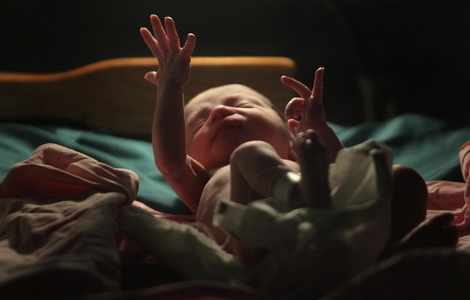China tweaks its famliy planning policy
Updated: 2011-10-31 22:37
(Xinhua)
|
|||||||||||
BEIJING - Leng Xuefeng used to beg to have a male offspring after his wife gave birth to a daughter two years ago.?Leng's wishes did not go unanswered, but in fact were responded to in an exceedingly generous fashion: his wife became pregnant earlier this year and gave birth to twin boys in October.
Both Leng and his wife are the only children in their respective families and are thus entitled to have a second child due to a recent change in China's decades-old family planning policy.
The policy, which used to limit urban couples to having only one child, has now been modified to allow any couple to have a second child, as long as both parents are only children themselves.
In a culture where a newborn male is considered to be a blessing, Leng's words after the birth of his sons sounded somewhat ungrateful.
"Now my account will have to be frozen to save for my son's dowry," wrote the 30-year-old low-ranking official on his microblog.
Leng and his wife will have to support the twins until at least 2030, when millions of young men of marrying age might not be able to get married due to China's gender imbalance.
In addition, tuition fees for three children will cost a fortune for the couple, who live in the sprawling metropolis of Chongqing in southwest China.
"Even when they grow up, they will be facing competition from their peers in job-hunting and find it difficult to support their elders," Leng said.
The worries of the Leng family reflect the anxieties that are haunting both policymakers and young parents, as they must figure out how to tackle the issues brought about by a changing demographic structure.
Family planning policy will not change
China will adhere to using a family planning policy, as overpopulation remains one of the major challenges for China's social and economic development, the country's family planning chief said in an interview on Sunday.
China will continue to use the policy, which was introduced in the 1970s, in order to maintain a low reproduction rate, said Li Bin, director of the State Population and Family Planning Commission.
Until the recent change, urban families were allowed to have just one child, while farmers and ethnic minorities were allowed to have a second child if the first was a girl.
Government statistics show that as one of the results of the policy, 400 million people were prevented from being added to the mainland's population, which currently stands at more than 1.34 billion.
Zhai Zhenwu, a leading Chinese demographer at Renmin University of China, said last week that China's family planning policy postponed the day for the world population to hit the 7-billion mark, which falls on Monday, for five years.
Lu Jiehua, a sociologist at Peking University, said the policy has helped reduce the size of the impoverished population in China and increased disposable income for both urban and rural residents.
However, Lu also sees the policy as having an unintended effect, creating both a rapidly aging population and a shrinking work force. Just over 13 percent of China's population is made up of people aged 60 or above.
It is expected that the ratio will hit one-third, or 440 million, by 2050, with one-fifth of the population reaching 80 years of age or older by that time, according to Li.
Some experts have concluded that China may lose its status as a global manufacturing hub, being replaced by its neighbor India, which now has 1.21 billion people and is forecast to overtake China as the world's most populous nation by 2030.
Zhai believes China will maintain its manufacturing edge for another 10 to 15 years, fueled by plentiful and cheap labor.
"China's current labor force stands at 930 million, far exceeding the combined work force of all industrialized nations at 770 million," Zhai said.
However, the development of China's demographic structure will expedite a change to its labor-intensive economy toward a more sustainable growth model and improved labor productivity to compensate for losses in its labor force, according to Zhai.
More challenges
In addition to overpopulation and aging, China is still facing other population-related challenges, including a gender imbalance, Li said.
Chinese parents' traditional preference for sons and the family planning policy have resulted in an imbalanced gender ratio.
The male-female ratio at birth in China is about 119 males to 100 females, well above the average of 104 to 107 boys for every 100 girls in developed countries.
Millions of Chinese men of marrying age might not be able to get married by 2020 due to the gender imbalance, a trend that experts believe will threaten social stability.
In addition, although the average education term has been extended, the ratio of highly educated people in the main labor force stands only 12 percent, lagging far behind the average level in developed countries.
Meanwhile, the rate of infant defects in recent years has stood at 4 to 6 percent, and people with disabilities account for 6.34 percent of the aggregate population, said Li.
"We must stick to the existing policy, raise the quality of the population and optimize its structure in order to ensure sustainable development in our population, society, environment and economy," Li said.
Hot Topics
Libya conflict, Gaddafi, Oil spill, Palace Museum scandal, Inflation, Japan's new PM, Trapped miners, Mooncake tax, Weekly photos, Hurricane Irene
Editor's Picks

|

|

|

|

|

|







